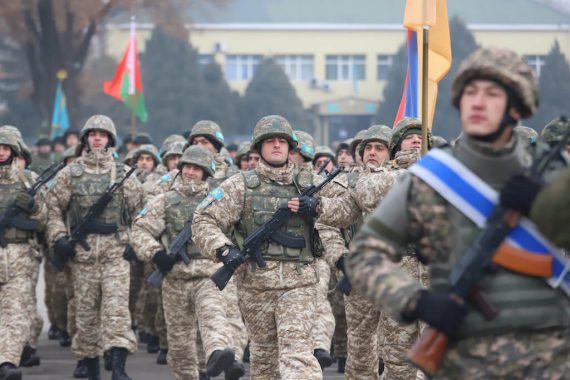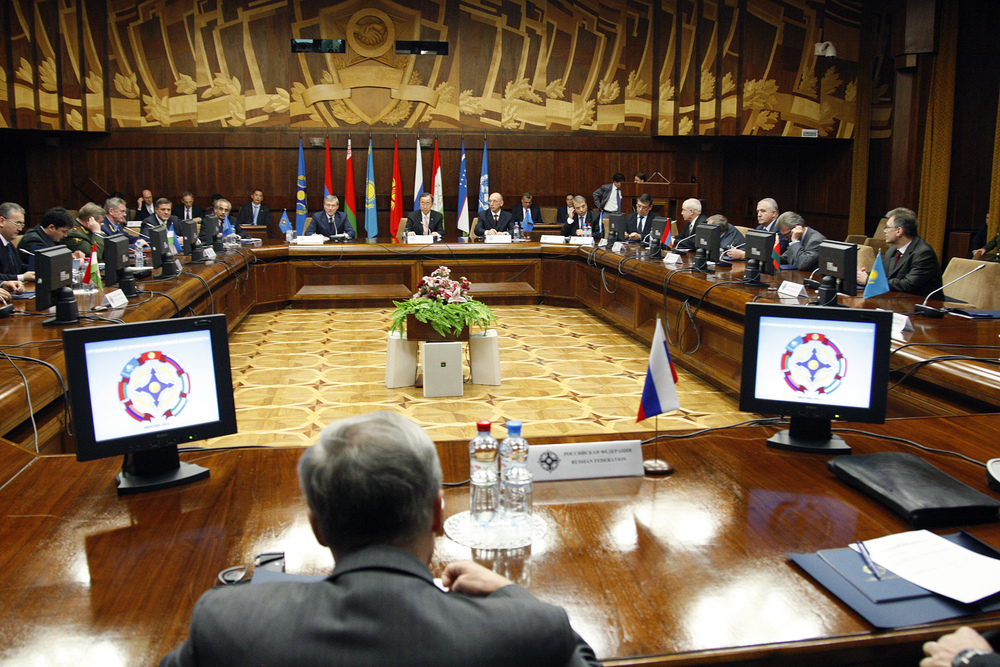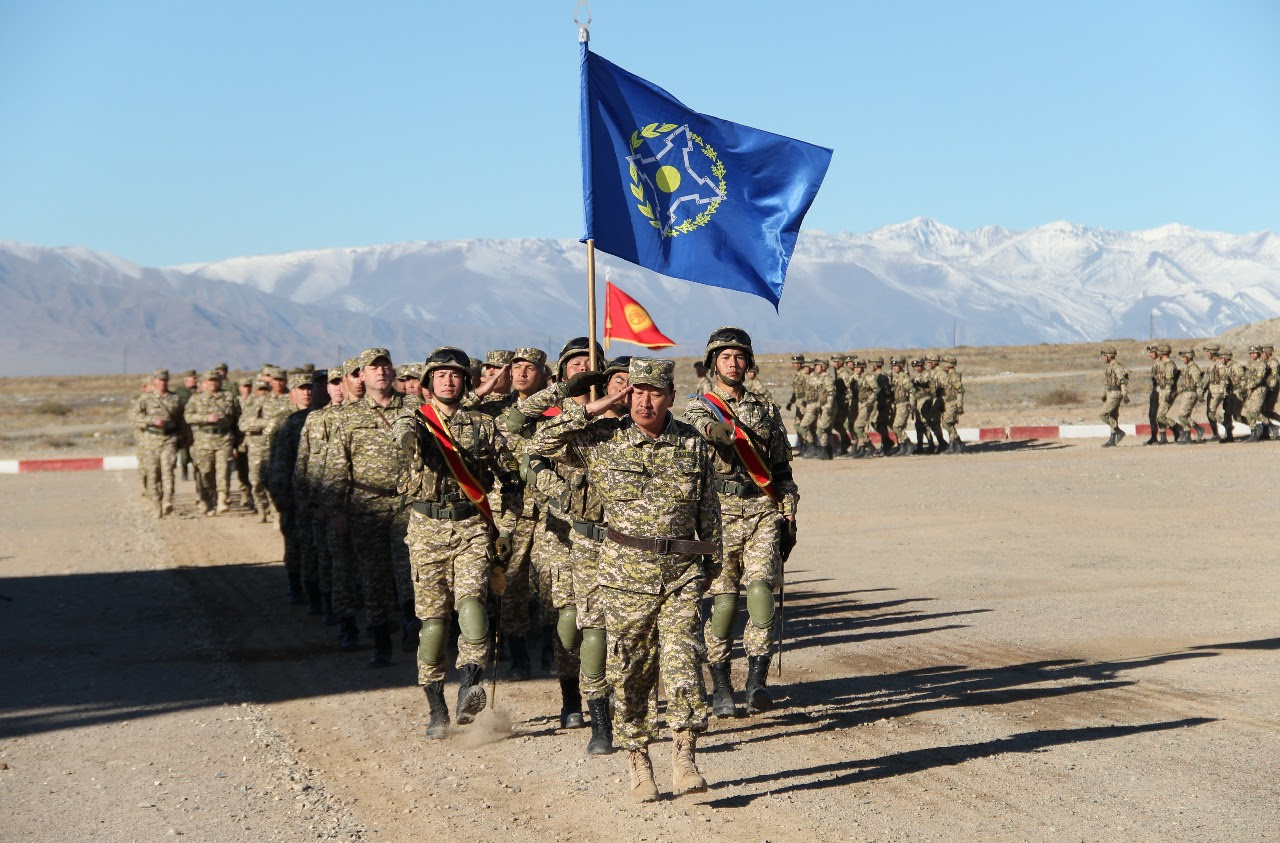The Russian-led military alliance, the Collective Security Treaty Organization (CSTO), created headlines in January 2022 after 2,500 of its troops entered Kazakhstan to assist in restoring order during anti-government protests in the country. The troops, sent in to secure Kazakhstan’s vital infrastructure, “helped stabilize” the government enough to allow them to put an end to the unrest. For many political observers, the intervention in Kazakhstan was the CSTO’s first notable operation, which has come after years of attempts by Russia to build an international organization capable of reshaping regional and global security while trying to dilute the power of the North Atlantic Treaty Organization.
The Commonwealth of Independent States (CIS), “a loose club of post-Soviet countries,” signed the Collective Security Treaty (CST) in 1992 after the collapse of the Soviet Union. The treaty eventually came into force two years later in 1994. Consisting of Armenia, Georgia, Belarus, Kazakhstan, Kyrgyzstan, Russia, Tajikistan, Azerbaijan and Uzbekistan, the treaty was meant to help coordinate military policies between former Soviet states.
But the initiative failed to spur any real military integration, and three of the nine members—Azerbaijan, Georgia and Uzbekistan—chose to leave in 1999, during the renewal of the treaty. Following Vladimir Putin’s rise to the Russian presidency, Russia began taking steps to modernize and strengthen the organization. This included granting the Collective Security Treaty the status of an “international regional organization,” after which it came to be known as the CSTO; increasing military exercises and integration between member states and creating the CSTO Collective Rapid Reaction Forces in 2009; which is meant to “[accomplish] tasks of both military and special nature.”

CSTO troops on parade at the Nurmagambetov Land Forces Military University in Almaty, Kazakhstan on January 13, 2022.
Though the CSTO is often simply viewed as a vehicle for Russian influence, the greatest critique from member states has been the organization’s lack of support during their times of crisis, undermining perceptions of its effectiveness. The Kyrgyz government had sought help from the CSTO in 2010, but the organization declined to help restore order following clashes between ethnic Kyrgyz and Uzbeks in the southern part of the country. The CSTO stated that it was not authorized to do so and had cited “the organization’s lack of mandate to intervene in the domestic affairs of its members.”
Additionally, the CSTO failed to condemn Turkey when it shot down a Russian bomber while it was flying over Syria in 2015—according to Russia—as member states were keen to keep positive relations with Turkey. In 2021, Tajikistan declared not enough was being done by the CSTO to help it deal with instability in neighboring Afghanistan. In 2020, Armenia called on the CSTO for aid during its conflict with Azerbaijan but because the fighting was largely taking place in what is internationally recognized as Azeri territory, Armenia’s request was denied by the CSTO. However, Azeri forces have also fired on the internationally recognized Armenian border, with minimal response from the CSTO.
But these limitations that seemed to have prevented the CSTO from taking action in the past appear to have been lifted, after looking at the action taken by the organization in Kazakhstan. The CSTO intervention in January has clearly demonstrated the organization’s worth to its member states. It provided integral international and domestic legitimacy to Kazakhstan’s government under President Kassym-Jomart Tokayev, while easing the logistical constraints of Kazakh security forces by allowing them to focus their efforts on confronting the protesters. The CSTO’s assistance in Kazakhstan contrasted with the lack of support by other organizations and states. The Shanghai Cooperation Organization (SCO) offered only half-hearted attempts to intervene during the anti-government protests in Kazakhstan, and despite China’s enormous investments in Kazakhstan and public support for Tokayev, Beijing’s support was limited to condemning the protests. The United States’ calls for calm were echoed by the European Union, with NATO expressing its concern over the protests in Kazakhstan.
The CSTO might benefit from assuring the governments of its member states about receiving support from the organization when needed, especially since these countries have been increasingly concerned about the threat of protests or revolutions. Perhaps wary of showing his dependency on Russia, Belarusian President Alexander Lukashenko did not appeal to the CSTO for assistance in 2020 as he faced mass protests against his reelection. But the CSTO’s success in Kazakhstan, coupled with its quick departure from the country, was not missed by Lukashenko or the leaders of other member states of the CSTO.
The CSTO is also likely to take a larger role in mediating disagreements between member states in the future, having already taken some steps to help manage flareups relating to the Tajik-Kyrgyz border dispute in 2021.
But the organization’s future actions may not be limited to the territories of its member states. The first international deployment involving two of the CSTO members has already taken place in the Middle East. In early 2019, Armenia deployed dozens of its soldiers to Syria for a “Russian-backed demining and humanitarian mission.” The Armenian government stressed on the non-military nature of the deployment, but this mission marked integrated operations among CSTO member states abroad for the first time.
The CSTO’s Kazakh operation in January also opens the door for other similar international organizations to launch their own military interventions to suppress unrest in their member states, without the support of the United Nations or NATO. NATO’s two-decade campaign in Afghanistan has revealed its own limitations, and organizations such as the Arab League or Association of Southeast Asian Nations (ASEAN) may take their own actions in member states following the new standard set by the CSTO.
For Russia, the benefits of the organization are clear. Its military now has unrivaled access across the territories of the CSTO member states. In 2011, member states gained “the right to veto the establishment of new foreign military bases in the member states of the CSTO,” giving the Kremlin considerable reach over their sovereignty and over a significant part of Eurasia. The Kazakh intervention managed to shore up a pro-Russian government in Kazakhstan while also underlining its dependency on Russia. And, without the officiating role of the UN, the EU, or other international bodies, Russia demonstrated that an organization it dominates acted as an effective crisis mediator and responsible actor in international affairs.

A CSTO Permanent Council meeting.
Russia’s efforts to promote the CSTO as an alternative to NATO in global security matters will likely require the organization to increase its membership. Serbia currently holds observer status in the parliamentary assembly of the CSTO, while the former Islamic Republic of Afghanistan was also an observer in the organization. Uzbekistan, which rejoined the CSTO in 2006 and left again in 2012, remains the top priority for the Kremlin.
In 2019, Russian Deputy Prime Minister Yuri Borisov also declared that Russia was open to the idea of giving Azerbaijan special partner status in the CSTO, which Armenia declared it would veto. And though drawing Ukraine back into Russia’s sphere of influence is currently a longshot, the Kremlin views Ukraine as the centerpiece of its 21st-century ambitions. Moscow will restart its efforts to integrate the country into Russian-led organizations like the CSTO when the opportunity permits.

Kyrgyz troops under the Collective Security Treaty Organization flag take part in joint military drills with other CSTO members in Kyrgyzstan.
Future CSTO operations abroad have also been hinted at. As the U.S. forces departed from Afghanistan in 2021, Russian, Tajik and Uzbek military forces held drills across the Tajik-Afghan border to demonstrate Russia’s commitment to Tajikistan’s border security. But this move also demonstrated Russia’s ability to help decide the fate of Afghanistan as the Taliban established control over the country. In 2019, the Russian Foreign Ministry also revealed its concept of collective security in the Persian Gulf region, signaling its intention to help regulate the area’s affairs.
The CSTO has proven that only Russia and the United States are willing and able to sustain viable international military alliances. As the CSTO’s profile continues to increase, Russia will have to continue balancing its geopolitical ambitions while demonstrating the benefits of the organization to fellow member states.
-------------------------------------------
By: Nicholas Waller
Title: Why it’s time to take the Russian-led military alliance seriously
Sourced From: www.neweurope.eu/article/why-its-time-to-take-the-russian-led-military-alliance-seriously/
Published Date: Fri, 04 Feb 2022 13:16:59 +0000
Read More
 UK PoliticsWorld PoliticsVideosPrivacy PolicyTerms And Conditions
UK PoliticsWorld PoliticsVideosPrivacy PolicyTerms And Conditions
